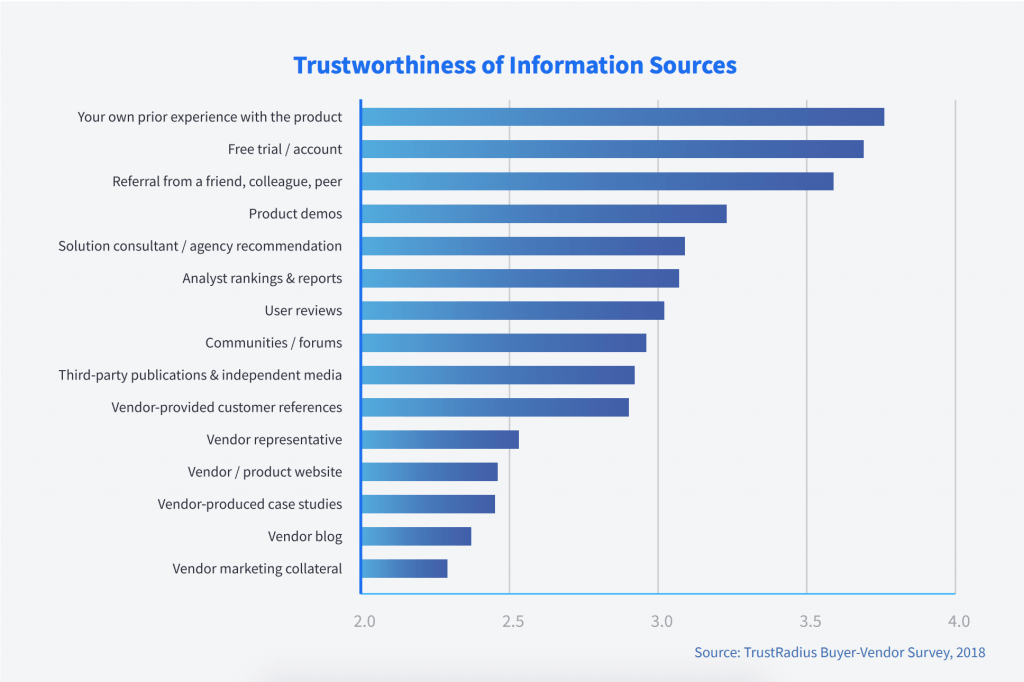
Reviews: Moving from Why to How
Time and time again, our data has shown that buyers don’t trust vendors. In fact, 85% of vendors say they’re open about their product’s limitations, however, only 37% of buyers thought their vendor lived up to that promise. In other words, buyers are very aware that vendor marketing and sales materials are going to be biased.
On the other hand, they do trust other users like them. It makes sense. They want a complete picture of the product — the good, the bad, and the ugly — and short of trying it for themselves, the best way for them to get that picture is through honest reviews from their peers.
Why You Need a Review Program
This is all well and good, but what does it actually look like in practice? Let’s turn to QuickBase and see how they tackled this issue.
Davin Wilfred, who runs the content and customer advocacy team at QuickBase, says: “I think a lot of people — especially those who work in marketing — kind of find themselves falling backward into a review site strategy. But I’ve found that thinking strategically about what your actual review site strategy is, which of the sites you’ll focus on, how you’re going to drive reviews, and for what purpose really opens up a lot of doors.”
In the case of QuickBase, they wanted to get their brand out there more. They’re in an emerging category of software tools and wanted to make sure they were making it onto potential buyers’ shortlists. Ideally, they’d also be enabling their sales and marketing teams to get more value out of customer-related content.
They were also doing all of this without the kinds of resources that many marketing teams have. “Frankly, it’s just way too difficult to do that through the heavy lifting involved with case studies or other kinds of customer-focused programs that more traditional marketing teams might employ,” notes Davin. The drive to start a review program came from realizing the huge opportunity in such an effort, and recognizing that they could do more than simply ask some customers to write reviews. “We realized we could really bake it into our overall marketing and sales process.”
Moving from Why to How: Choosing Key Milestones
Victoria LaPlante, who has run review programs at HubSpot and now at Influitive, says that a large part of growing your customer advocacy program is identifying who your key advocates are and, in turn, mobilizing them to drive social proof via tools like product reviews. “As a best practice, both at HubSpot and Influitive, I found that the best advocacy programs are very strategic on when they ask their customers for product feedback and online reviews,” she notes.
At Influitive, they pick key milestones across the customer’s journey. For example: after a customer has completed their user onboarding and implementation. At this point, they’re starting to see success, so it’s a great time to check in and see how things are going.
After that milestone has passed, Influitive uses their advocate hub (you can also use a traditional email survey) to ask how the process went. Key questions include if they are starting to see value and if they’re likely to recommend the product or company to a peer or colleague. Based on the responses they collect from respondents, they then invite the advocate to leave a review, since the feedback they’re providing is core to how Influitive will grow and improve.
The Three Pillars of Actually Getting Reviews
Once you’ve decided on when to reach out, Michael Beahm, a Customer Success Manager at TrustRadius who previously worked at Blackbaud, has tips on specific tactics that you can use to scale reviews. According to Michael, there are three pillars when it comes to driving and scaling reviews with customers:
- Use traditional email and nurture campaigns sent to a targeted customer list.
- Gather reviews at events where large amounts of customers are gathered in one spot.
- Think outside the box and reach out via channels that make sense for your business — with in-app prompts, during Customer Success conversations, in newsletters, or even by adding the review program link to the email signature of anyone who communicates regularly with your customer base.
Now that you know why you need a review program and have some tips on getting started, you may be wondering who should actually own and manage reviews. Deciding who should don the cape is easier than ever with our eBook, Are You a Customer Review Superhero?. Download your copy now!







